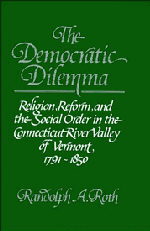 The Democratic Dilemma
The Democratic Dilemma Book contents
- Frontmatter
- Contents
- List of tables and maps
- Acknowledgments
- Introduction
- 1 The revolutionary frontier, 1763–1800
- 2 The failure of the covenanted community and the standing order, 1791–1815
- 3 Religion and reform in the shaping of a new order, 1815–1828
- 4 From an era of promise to pressing times, 1815–1843
- 5 A clamor for reform, 1828–1835
- 6 The great revival, 1827–1843
- 7 A modified order in town life and politics, 1835–1850
- 8 Boosterism, sentiment, free soil, and the preservation of a Christian, reformed republic
- Conclusion: Religion, reform, and the problem of order in the Age of Democratic Revolution
- Appendix A Church records
- Appendix B Types of towns
- Appendix C Occupational groups
- Appendix D Statistical methods
- Notes
- Index
5 - A clamor for reform, 1828–1835
Published online by Cambridge University Press: 04 August 2010
- Frontmatter
- Contents
- List of tables and maps
- Acknowledgments
- Introduction
- 1 The revolutionary frontier, 1763–1800
- 2 The failure of the covenanted community and the standing order, 1791–1815
- 3 Religion and reform in the shaping of a new order, 1815–1828
- 4 From an era of promise to pressing times, 1815–1843
- 5 A clamor for reform, 1828–1835
- 6 The great revival, 1827–1843
- 7 A modified order in town life and politics, 1835–1850
- 8 Boosterism, sentiment, free soil, and the preservation of a Christian, reformed republic
- Conclusion: Religion, reform, and the problem of order in the Age of Democratic Revolution
- Appendix A Church records
- Appendix B Types of towns
- Appendix C Occupational groups
- Appendix D Statistical methods
- Notes
- Index
Summary
During the winter of 1834, when concern over the decline of proprietorship and public morals had reached a desperate peak, a committee from Woodstock called a meeting of the freemen of the county to discover what “extraordinary cause” had brought about “the unusual pressure” of the times. The committeemen believed, as did people throughout the burned-over districts, that the circumstances in which they found themselves were as threatening to the freedom and happiness of the citizenry as George III's plot against American liberty. In language that echoed the dramatic rhetoric of the revolutionary era, they described a political conspiracy against their rights and property and a moral declension that had caused people to neglect their duty to defend the public good and had disposed some men to place their private interests over that good. Although they could not reach a consensus on the cause of their predicament, there was general agreement that the young republic, which had seemed so stable in the postwar years, was in real danger of coming undone.
To preserve the republic and encourage people to rededicate themselves to the ideals of nondenominational Christianity and nonpartisan republicanism, the valley's inhabitants embraced a flurry of reform movements between 1828 and 1835. The movements originated outside the valley, but Vermonters took them up, particularly Antimasonry, antislavery, and temperance, with a fury and intensity unknown outside the burned-over districts. Unlike postwar reform movements, which were organized as voluntary societies, most of these movements were organized as political parties or as petition campaigns against specific government policies.
- Type
- Chapter
- Information
- The Democratic DilemmaReligion, Reform, and the Social Order in the Connecticut River Valley of Vermont, 1791–1850, pp. 142 - 186Publisher: Cambridge University PressPrint publication year: 1987


